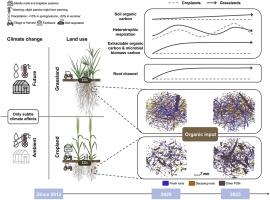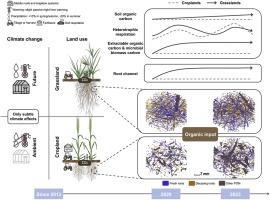响应土地利用和气候变化的土壤微观结构动态与碳循环的联系
IF 10.3
1区 农林科学
Q1 SOIL SCIENCE
引用次数: 0
摘要
土地利用系统在有机碳输入和微生物矿化之间的平衡存在差异,影响土壤长期碳储量。多年生草地无需耕作,保持根系连续生长,促进土壤稳定微观结构和生物孔的积累。相比之下,一年生农田经历休耕期和周期性耕作,这扰乱了土壤微观结构,加速了物理保护碳的矿化。然而,土壤微观结构对碳循环的调控强度及其对气候变化的响应尚不清楚。本文从建立后第5年开始,研究了当前和未来5年气候情景下的5种土地利用类型(2种农田和3种草地)。未来气候情景反映了温度升高和降水变化的区域预估。利用基于深度学习的x射线CT图像分割,我们发现,由于持续的根系活动和周转,草地始终含有更高体积的生物孔、颗粒物有机质(POM)和腐烂的根系。春季农田鲜根相对较多,可能是由于一年生植物早季生长迅速、休耕期微生物活性降低以及全年根系投入不足所致。典型的草地微结构在表层土壤(5 ~ 10 cm)经过4 ~ 5年发育完全。10年后深层土壤(35 ~ 40 cm)的土地利用差异仍然很小。草地微生物生物量碳和可提取有机碳均较高,而总有机碳分化较慢。未来气候情景主要通过土壤水分影响异养呼吸和活性碳库,但对表层土壤微观结构和碳库的影响不显著。POM体积,而不是孔隙结构,是碳矿化的关键驱动因素,因为这些微生物热点的曝气不受限制。这些发现强调了根通道密度和根系退化指标等微观结构特征在量化包括碳储量在内的长期生态系统发展方面的潜力。本文章由计算机程序翻译,如有差异,请以英文原文为准。


Links between soil microstructure dynamics and carbon cycling in response to land use and climate change
Land-use systems differ in the balance between organic carbon inputs and microbial mineralization, affecting long-term soil carbon storage. Perennial grasslands maintain continuous root growth without tillage, promoting the accumulation of stable soil microstructure and biopores. In contrast, annual croplands experience fallow periods and periodic plowing, which disturb soil microstructure and accelerate the mineralization of physically protected carbon. However, the strength of soil microstructural regulation on carbon cycling and its responses to climate change remains unclear. Here, we studied five land-use types (two croplands and three grasslands) under ambient and future climate scenarios over five years, starting from the fifth year after establishment. The future climate scenario reflected regional projections of increased temperature and modified precipitation regimes. Using deep-learning-based X-ray CT image segmentation, we found that grasslands consistently contained higher volumes of biopores, particulate organic matter (POM), and decaying roots due to sustained root activity and turnover. Croplands exhibited a higher relative amount of fresh root in spring probably due to the rapid early-season growth of annual species, reduced microbial activity during fallow periods, and lack of year-round root inputs. A typical grassland microstructure fully developed in topsoil (5–10 cm) after 4–5 years. Land-use differences in deep soil (35–40 cm) remained small even after 10 years. Microbial biomass carbon and extractable organic carbon were consistently greater in grasslands, whereas total organic carbon diverged more slowly. The future climate scenario primarily influenced heterotrophic respiration and labile carbon pools through soil moisture, but did not significantly alter topsoil microstructure or carbon pools. POM volume, rather than pore structure, was the key driver of carbon mineralization, as the aeration of these microbial hotspots was not limiting. These findings highlight the potential of microstructure characteristics like root channel density and root degradation indicators to quantify long-term ecosystem development including carbon storage.
求助全文
通过发布文献求助,成功后即可免费获取论文全文。
去求助
来源期刊

Soil Biology & Biochemistry
农林科学-土壤科学
CiteScore
16.90
自引率
9.30%
发文量
312
审稿时长
49 days
期刊介绍:
Soil Biology & Biochemistry publishes original research articles of international significance focusing on biological processes in soil and their applications to soil and environmental quality. Major topics include the ecology and biochemical processes of soil organisms, their effects on the environment, and interactions with plants. The journal also welcomes state-of-the-art reviews and discussions on contemporary research in soil biology and biochemistry.
 求助内容:
求助内容: 应助结果提醒方式:
应助结果提醒方式:


